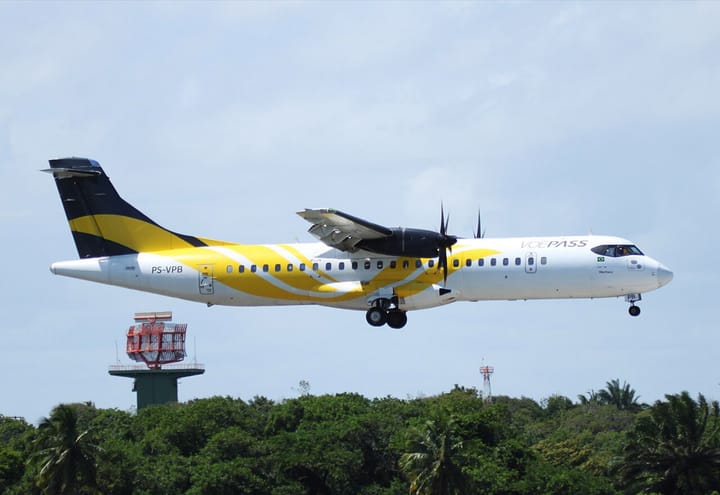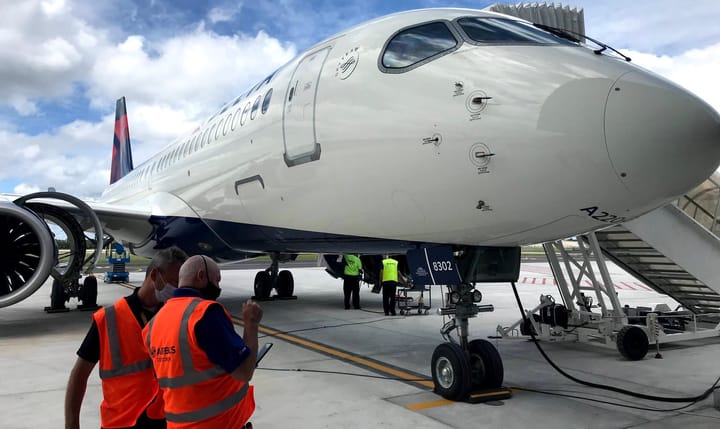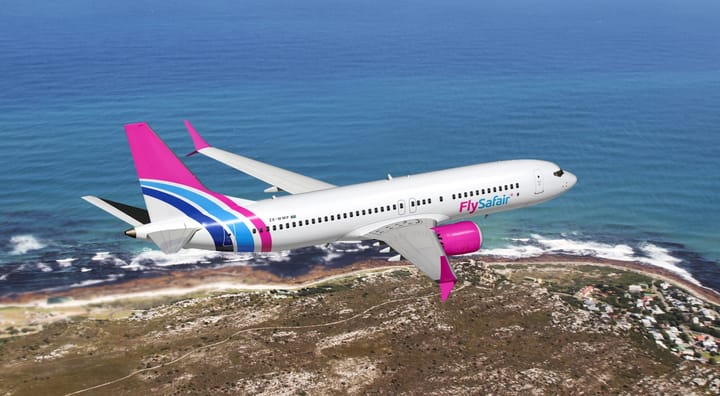The South African airline industry has seen it’s fair share of change and upheavals in the last few years. The COVID-19 pandemic flipped the industry on its head, and devastating though the impact was, it has given birth to a new chapter in the country’s aviation history.
In early 2018, the landscape of the South African airline industry looked the way it had been looking for most of the new millennium. Comair, who had operated low cost carrier Kulula in addition to the British Airways brand under a franchise agreement, had a strong foothold in Southern Africa albeit with strong competition from state-owned low cost carrier Mango, and then still infantile FlySafair. Airlines like Airlink, SA Express and Cemair filled in gaps on less popular routes to smaller airports in South Africa and neighboring countries.
South African Airways meanwhile had not operated profitably in many years, and continued to take advantage of government bailouts, much to the ire of the South African tax payer who thanks to the relentless efforts of the South African media were well aware that there was more fraud taking place at SAA than money being made. This was the picture as it stood in early 2018, and even before the COVID pandemic had started, a period of volatility was about to begin.

Death of SA Express
SA Express started it’s operations as a state-owned short-haul airline back in 1994 when South Africa gave birth to it’s democracy. The airline operated flights based mainly out of Johannesburg, flying to destinations like Bloemfontein, Port Elizabeth, Kimberley and Richards Bay amongst others, mainly operating a fleet of De Haviland Dash 8’s and Canadair CRJ’s. It had operated quite successfully for some time, but based on available data didn’t seem to have run profitably from 2010 onward, reporting net losses to the tune of tens of millions of dollars annually in the last 8 years of operation.
In May of 2018, SA Express had become the subject of a South African Civil Aviation Authority (SACAA) audit that found several issues related to non-compliance to certain safety standards it enforced on the industry, and grounded the airline indefinitely. It was expected to remediate the safety concerns and provide proof of its compliance before it could operate again, but it turned out to be too much, and less than 2 years later the airline entered the business rescue process to protect it from bankruptcy. The COVID pandemic hit only a short while after though, and proved to be its final death knell. Operations were ceased permanently on 28 April 2020.

Comair perishes to COVID
Comair had its roots way back in 1942, operating flights between Johannesburg and Durban using Douglas DC-3’s. The company developed over time and was eventually taken over by Dave Novick in a landmark legal battle with the company’s original owners after a management buyout agreement had gone awry. The airline flew charter operations and smaller routes using ATR-42’s in the early 1990’s, and thanks to Novick’s favorable relationship with British Airways, eventually secured a franchise agreement that meant the company could fly under the BA brand. In 2001 Gido Novick and Erik Venter started what was to be South Africa’s first low cost airline called Kulula, and that was where the airline truly started to find its stride, at the time operating a mixture of Boeing 737-200’s and MD-82’s. The airline’s fleet was gradually upgraded as the years passed, using 737-300’s, -400’s and eventually -800’s. Operating the two brands over time Comair was eventually in a dominant position in the South African domestic air transport market, operating on a profit of around $58 million by 2019 when it was at it’s peak.
In the same year Comair took delivery of its first of eight Boeing 737 MAX-8 aircraft before the Lion Air and Ethiopian disasters forced the grounding of the type globally. The MAX-8’s had only managed a few sectors between Johannesburg and Cape Town before the grounding took place, and it was eventually flown to Arizona for long term storage, never to return to the airline. The airframe in question now flies with Cabo Verde Airlines in Cape Verde. Comair was on the precipice of a new chapter in its history at the time, but the COVID pandemic saw the airline’s fortunes reverse, posting net losses in 2020 for the first time in it’s recent history, and entered business rescue. Comair continued operating until June 2022 when doors were shut permanently. Years after the airline had ceased operations, attempts were still being made to claim damages from Boeing for losses sustained as a result of advance payments made for the 737-MAX8’s that had not been delivered. The outcomes of that case are still pending at time of writing.
Mango
Mango Airlines, a subsidiary of South African Airways was started in 2006 as the state-owned enterprise’s answer for the low-cost market, entering into direct competition to Kulula. Boeing 737-800s that had been flying under the SAA flag were moved to the low-cost carrier, leaving SAA with an all Airbus fleet.
Between 2006 and 2021, Mango logged inconsistent performances. Though the airline had seemed to be a viable enterprise in it’s first few years of operation, it ran into many problems, some of which were inherited by a culture of mismanagement that was deeply entrenched at SAA. The airline seemed to survive through the COVID pandemic (although this was largely thanks to its state backing), but in April of 2021 Mango was grounded due to non-payment of outstanding invoices to South Africa’s main airport management company ACSA (Airports Company of South Africa). The management company refused to allow Mango to use any of its facilities until its debts were settled. The situation remained unresolved however, and in August of 2022 Mango’s operating license was suspended altogether.
The Black Sheep
When talking of the South African Airline industry, one inevitably has to mention South African Airways (SAA), however reluctantly. The airline has a rich history that stretches back all the way to 1939, and operated proudly for decades. However, the new millennium brought only dismay to SAA, and the airline has been reduced to a shadow of its former self due to extraordinary levels of mismanagement compounded by a series of gross and embarrassing cases of fraud. The airline, in its mismanaged state, had relied on government bailouts that have over the years costed the South African tax payer dearly. The South African government had started facing increased public pressure to cease its bailouts of SAA, and as with other airlines, SAA ceased operations during the COVID pandemic. It resumed operations in 2021 in a far smaller capacity than before, and has since seen a slow but steady growth. The airline currently has a fleet of six Airbus A320’s, one Airbus A330, one Airbus A340 and two Boeing 737-800’s on wet-lease from Sun Express. It also recently resumed one of its old intercontinental routes to São Paulo. Whether the airline can survive long term remains to be seen.
From the ashes
The aviation sector in South Africa took a beating during the COVID pandemic (much like many airlines around the world at the time), but this was exacerbated by draconian and often misguided measures put in place by the South African government to curb the spread of the virus. Fortunately though, a handful of airlines survived the onslaught, and took advantage of the downfall of some of the country’s more unfortunate airlines.

FlySafair
The FlySafair brand was started by Safair, an airline that was mainly focused on cargo and charter operations for most of its history. Having started in 1965. The company had its niche flying cargo operations and was famed for its involvement in a variety of humanitarian missions. In 2014 it made its entry into the South African low-cost market, initially flying a handful of Boeing 737-400 airframes it already had in its fleet on routes between Johannesburg, Cape Town, Durban and Port Elizabeth. The airline’s growth could hardly have been described as aggressive in these early stages, being run by a small but passionate team, who one can only imagine had no idea how much the airline would grow in the following years.
With the death of Comair and Mango, the door was open for the airline, and between 2020 and the present day, the airline went from being a quiet third placed contender, to dominating the local domestic routes in South Africa.To put this into perspective, FlySafair had 5 aircraft in it’s fleet when they entered the market flying only on South Africa’s busiest few routes. By the end of 2023 that had grown to 28 aircraft, and now fly to 15 destinations in Southern Africa. Ironically a lot of their current aircraft are former Comair and Mango examples.
Airlink
One may be forgiven for thinking that FlySafair is the largest airline in South Africa, but one would be wrong. Seemingly flying under the radar and being one of only a couple of COVID-19 survivors, Airlink has moved from strength to strength, and as with FlySafair, Airlink has seen great growth in the post COVID era. Formed out of a small handful of existing airlines in 1992 by Roger Foster and Barrie Webb, the airline was officially launched under the Airlink brand in 1995. In 1997 Airlink partnered with SAA (along with SA Express) under a franchise agreement, collectively forming the largest network in Africa at the time. The partnership saw the airline grow substantially, until it was ended in 2000, breaking away from the embattled SAA.

Over the years Airlink operated a collection of aircraft including Boeing 737-200 and -300s, Avro RJ’s / BAe 146’s, Embraer ERJ 135 and 145s, and BAe Jetstreams on its smaller routes. In 2017 the airline took delivery of it’s first Embraer E170 as part of it’s fleet modernization program. Subsequent to this the airline added the Embraer E-190 to the fleet as well, and by the end of 2023 had phased out the last of its ageing fleet of Jetstreams. At the time of writing, Airlink’s fleet now consists almost exclusively of Embraer airframes with the exception of a single Boeing 737-300. The airline retains its fleet of smaller Embraer ERJ 135 and 145s (of which it has twenty-four examples), two E-170s and 25 E-190/195s.
Collectively Airlink has a fleet of 56 aircraft and fly to 26 destinations outside of South Africa in addition to 18 major and smaller destinations within the country, which currently makes it South Africa’s largest airline in terms of fleet size and destinations. The airline is also the only operator to fly to the island of St Helena.
The South African airline industry has seen its fair share of uphill battles. The South African economy notwithstanding, these mavericks continue to forge ahead in very challenging environments. Depending how the future pans out, these airlines could well one day extend their grasp even further outside of the borders of South Africa, and one can only hope that they do continue to thrive.
Sources:
https://web.archive.org/web/20200630021739/
https://www.comair.co.za/Media/Comair/files/2019/annual-report/comair-annual-report-2019.pdf
https://kiosk.flysafair.co.za/about-us/history-of-safair
https://www.airfleets.net/chart/Safair-fleet-chart.htm
https://www.airfleets.net/flottecie/South%20African%20Airways.htm





